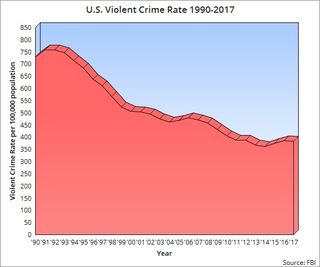Law and Crime
Video Games: Cause of Crime or Prevention?
The decline in U.S. crime was triggered on December 3, 1994.
Posted August 29, 2019 Reviewed by Ekua Hagan
When I was growing up in the 1960s and '70s, I would get home from school, do my homework, then go outside—usually on my bicycle—to look for someone to play with. By the time I was a teenager, it was no longer about “playing,” we were trying too hard to be cool, instead it was about “hanging out.” I would go out into the neighborhood and see who was outside. I looked for kids close to my age because many of the older boys were bullies.
One day when I was 13, I was hanging out with one of my friends, when his older brother and a group of his upper-middle-class friends came along. They allowed us to tag along with them to the mall. On the way there, I watched the half dozen 15-year-old boys break into and vandalize an unoccupied building. Then they found some plastic sheeting, which they hung over a tree branch and lit on fire because of the nifty “zip” sound the dripping burning plastic made as it fell to the ground. At the mall, they shoplifted. On the way home, we stopped in the woods where they showed off their loot. One kid produced a tiny handgun he’d stolen; I thought for sure it must be fake because I didn’t know of any stores in the mall that sold guns. Then they smoked cigarettes and marijuana, and drank whiskey from a flask. In one two-hour outing, I felt like I’d been exposed to nearly the full gamut of illegal activities to which male teenage boredom can lead.
That’s what kids did, in the years before 1995, they went outside and looked for something to do. Something with which to entertain themselves. At the end of 1994, however, something changed; something that would keep boys and young men inside. Something that would reduce the crime rate dramatically.
Attempts at explaining the falling crime rate

Crime rates in the United States began to rise in the early 1960s, then peaked in the early 1990s. Then suddenly in 1995, they began to fall. They continued to fall reaching a 40-year low in 2010 as reported by the FBI. Remarkably, most people are unaware of this drop. I blame that on the media for sensationalizing the crime that does occur.
There have been many attempts at explaining the falling crime rate, but so far most have been refuted. Some of those explanations include:
- Roe vs. Wade reduced unwanted pregnancies; however, studies estimate that there were an average of 800,000 illegal abortions per year prior to 1973 which is not significantly lower than the annual number of legal abortions after 1973; nor was there an increase in crime related to the decrease in abortions that occurred during the 1980s;
- Prosperity and a good economy lead to less crime; but this doesn’t explain why crime continued to fall during the Great Recession;
- Decreasing alcohol consumption by Americans; this might explain a reduction in assault and rape, but not murder or burglary, also Canadians and Europeans drink more than Americans without an increase in crime;
- Longer incarceration; this hasn’t worked because men age out of criminal activity around age 30 which makes longer sentences ineffective, plus harsh sentences tend to increase recidivism;
- Stop and frisk policies; however, this didn’t hold true because crime continued to fall even after these policies were discontinued;
- The Clean Air Act of 1970 eliminated lead from paint and gasoline; but additional studies of the National Crime Victimization Survey degraded the correlation between lead exposure and violent crime;
- Additional theories for the decrease in crime include such factors as increased gun ownership, antidepressant prescriptions, and cell phone use.
To be fair, the reduction in crime might be a combination of all these factors. However, I have a theory of my own, and it holds up better than any of the others.
Who commits the most crime?
The people committing the most crime are males in their teens to early twenties in age. According to the National Institute of Justice, the peak age at which young men are most likely to commit a violent crime is around 18. And, the U.S. National Crime Victimization Survey reports that 12 to 24 is the age bracket most likely to commit a crime in general.
The Marshall Project, which produces non-profit journalism about criminal justice, reports that according to the Bureau of Justice Statistics, arrest rates peak at age 19 for homicide, age 18 for forcible rape, and age 16 for vandalism. They also report criminologist Alfred Blumstein’s findings that criminal careers are relatively short—about 5 to 10 years—for the crimes of murder, rape, robbery, aggravated assault, burglary, larceny, arson, and car theft.
Burglars and car thieves are usually finished with their criminal activities by their mid to late 20s. One of the reasons cited for this is that the human brain is not fully developed until age 25. In particular, it is the area of the brain, known as the prefrontal cortex, which controls impulsive and risky behavior, that is still developing.
So, why did 12- to 25-year-old males suddenly stop committing as many crimes starting in 1995?
The introduction of Sony Playstation
Yes, a home video game console made crime start falling. With the introduction of the Sony Playstation on December 3, 1994, kids, teenagers, and young adults, no longer had to go outside and search for mental stimulation. It was suddenly more fun to stay indoors and play video games. Starting in 1995, the statistical graph on crime started its steady downhill march. How is it possible for a video game to do that?
The Sony Playstation was revolutionary in many ways which enabled it to become the catalyst for crime rates to drop. It was a “game-changer” for the gaming industry. It offered arcade quality games with 3D graphics that could be played at home on a relatively inexpensive piece of hardware that hooked up to a television. Before 1995, you had to have an expensive PC on which to run games with high-quality graphics at home.
Playstation was also the first to introduce games on inexpensive CDs instead of bulky cartridges. Sony even added a portable memory card, so that you could take your game to a friend’s house and pick up from where you left off without starting over.
Perhaps the biggest innovation was that Sony allowed and encouraged third-party developers to create games for the Playstation which led to a plethora of games people could play. Until this revolutionary product hit the market, video game consoles were still considered children’s toys. The sophistication and complexity of the new games for Playstation made them more appealing to adults and moved the home gaming system from the kid’s bedroom into the living room.
Playstation’s superiority was so great that it turned the trend of playing video games at home into a juggernaut. It also triggered the furied competition between it, Atari, Nintendo, and Microsoft Xbox that continues today. The first Playstation sold over 100 million units, and Playstation 2 sold more than 155 million units.

Today, video games are a multi-billion dollar market. According to WePC.com the video games market is expected to be worth over 90 billion U.S. dollars by 2020, up from 78 billion in 2017.
There are more than 2.5 billion video gamers worldwide. In the United States, 64% of the general U.S. population are gamers (that’s 211 million people).
According to Statista.com, in the United States, 21% of video gamers are under age 18 (that’s 44 million people), and the largest group of video gamers at 40% are age 18 to 35 (that’s another 84.5 million people).
Of all demographics, 15- to 19-year-olds spend the most time playing video games. The average time spent by all teenagers playing video games is 2.5 hours per day. Remember that is the average of all teenagers. That means a lot of them are playing many more hours a day. Among the teenagers I know, 2.5 hours a day seems way too low.
What is the gender of most of these gamers? BigFishGames.com reports that between the years 2010 and 2016, 60% of video game players in the United States were male.
When you add it all up, young men of the age most likely to commit crimes are now playing video games at home. They are not wandering the streets in search of entertainment. It is the single best reason for why crime in the United States has been dropping for nearly 25 years.
Over the past decade, whenever I heard or read that crime rates were falling, I immediately thought of my sons, their friends, and my friends’ sons and how much they all love to play video games. It was obvious to me why crime was falling, boys were playing video games instead of roaming the outdoors and getting into trouble looking for something with which to amuse themselves.
My personal experience with video games is that they are quite addictive. When I need to get things done, I purposely avoid them. I recall several times sitting down to play around 10 o’clock at night, and telling myself that I would only play one hour then go to bed. I should’ve set an alarm because what felt like an hour passing turned out to be four hours. Then it was 2 o’clock in the morning, and I was irritated that I had cheated myself out of three hours of sleep.
Supporting my theory is a report published in 2011, titled: Understanding the Effects of Violent Video Games on Violent Crime by Benjamin Engelstätter, of the Centre for European Economic Research, Scott Cunningham, of Baylor University in Texas, and Michael Ward, of the University of Texas. They contend that people playing video games are too busy at home to be committing crimes. It states, “Time spent gaming cannot be spent on other activities, both legitimate activities and illicit violent activities."
This reminds me that the Millennial generation is reported to be having less sex than previous generations.† I suspect video games are probably having an impact on this too, but that’s another article for another day.
Additionally, Michael Ward’s study at the University of Texas found that for every 10 percent increase in the number of violent games sold, the crime rate dropped by 1 percent.
Also to support my theory, I offer the following quote from Christopher J. Ferguson, Ph.D., a professor of psychology at Stetson University, who wrote in The Conversation, “Spikes in violent video games’ popularity are well-known to correlate with substantial declines in youth violence – not increases. These correlations are very strong, stronger than most seen in behavioral research. More recent research suggests that the releases of highly popular violent video games are associated with immediate declines in violent crime, hinting that the releases may cause the drop-off.”
Motivated by the August 2019 mass shootings in Dayton, Ohio, and El Paso, Texas, the President of the United States, the governor of Texas, and a few other elected politicians have claimed that playing video games cause violent behavior. But these statements were made without any research to back them up. The facts show that video game playing has reduced all crime including violent crime. Some have theorized that playing violent video games may even satisfy the violent urges experienced by some young men.
Dr. Ferguson, who also says that his research generally indicates that exposure to media violence has little effect on societal violence, states, “[A]s a researcher who has studied violent video games for almost 15 years, I can state that there is no evidence to support these claims that violent media and real-world violence are connected. My own research has examined the degree to which violent video games can – or can’t – predict youth aggression and violence. In a 2015 meta-analysis, I examined 101 studies on the subject and found that violent video games had little impact on kids’ aggression, mood, helping behavior or grades.”
Elizabeth Ruiz with KATC-TV3 in Acadia, Louisiana reports that Dr. Asim Shah, a professor of psychiatry at Baylor College of Medicine, says the potential relationship between video games and gun violence has been studied for over a decade; "In the past, people used to think that there is a relationship, but the latest studies show that there is no correlation."
When unthinkable horrors occur, people expect explanations from their elected officials. When the problem is seemingly unexplainable, politicians seek a scapegoat to blame. Video games are merely the current scapegoat. However, when you look at the facts, video games are something to celebrate. They have provided us with more than two decades of falling crime.
Perhaps instead of fighting terrorism with soldiers, planes, drones, and warships, we should be saving tax dollars by sending free game consoles to all young men worldwide. Then perhaps the next Nobel Peace Prize will be awarded to a company that makes video games.
Copyright 2019, Robert Evans Wilson, Jr.
References
† See Declines in Sexual Frequency among American Adults, 1989–2014 an original paper by Jean M. Twenge, Ryne A. Sherman, Brooke E. Wells © Springer Science+Business Media New York 2017




